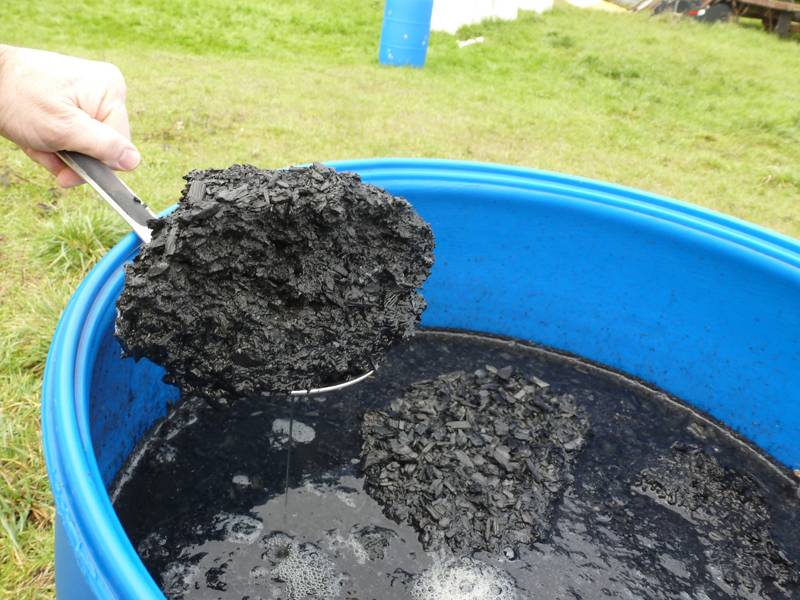
Biochar was discovered by purifier Charles Hegberg during a trip to Africa in 2006. When the restoration ecologist first looked into biochar research, much of it was still focused on agricultural or carbon sequestration applications, but Hegberg was working on water quality issues in the Midwest and the Chesapeake Bay.
"At some point, I had an epiphany and realized, 'Wait a minute, this is a Brita filter,” Hegberg explained.
The activated carbon used in Brita filters is a porous material, and pollutants become trapped in the tiny pores that run through the carbon granules. According to Gerardo Diaz, a mechanical engineer at the University of California, Merced, much of the activated carbon here comes from coconut shells shipped here from Asia. Certain
Biochar could eventually be incorporated into wastewater treatment plants' filtration systems. The California Association of Sanitation Agencies, for example, looked into the possibility of using biochar made from drought-killed trees in wastewater treatment plants, but the project failed to find a biochar filter that could compete on price or efficiency with traditional activated carbon.
"At some point, I had an epiphany and realized, 'Wait a minute, this is a Brita filter,” says Hegberg, Charles
Hegberg, now vice president of business development at the environmental consulting firm Ecotone, is already using biochar to filter stormwater where it lands by collaborating with Chesapeake Bay cities and transportation departments to identify green spaces that can be optimized to capture and filter more water during rainstorms.
Cities are largely impervious environments, with most of the land capped with concrete and asphalt as a result of development. Even in green spaces alongside roads and highways, or in grassy yards, the soils are so compacted that water frequently runs off without infiltrating the ground. "What you end up with is a scenario where the soils are nothing more than green concrete," Hegberg explained.
"In the long run, if you can get it to scale," Hegberg said, "you can actually start reducing flooding. This will be a huge benefit for cities as climate change increases the frequency and severity of extreme weather events.”
Selling Points
As the California Association of Sanitation Agencies discovered, not all feedstocks are suitable for biochar filters. Finding the right market for all of the different types of biochars out there is all about matching the biochar's properties to its intended use. One particularly difficult issue is what to do with contaminated biomass, such as pesticide-laced agricultural waste or sludge from wastewater treatment plants containing heavy metals.
"There will be some biochar produced from things that may contain heavy metals," Draper said. "It's simply safer to put it in something that isn't used to grow food."
These contaminated feedstocks could be ideal for producing biochar, which could aid in the conversion of abandoned oil wells into carbon sinks.
There are up to 3 million orphaned oil wells in the United States, with many of them potentially leaking methane and other gases. States and their taxpayers are responsible for capping and abandoning these wells so that they do not pollute the environment any further than they already have. OFX EcoSolutions wants to convert these thousands-of-foot-deep wells into carbon sinks by filling the space between the concrete plug at the bottom and the surface with biochar. They're taking a holistic approach to the abandonment process, using biochar to remediate the soil around the well's surface as well.
Biochar has been piped into a pilot well in Louisiana, and the company hopes to expand into Pennsylvania, Kentucky, Indiana, Michigan, and Colorado. "The reality is that we're not moving the needle very much on a case-by-case basis," said Mark Mersman, co-founder of OFX. "You might be able to extract 5 to 10 tonnes of CO2 equivalent from each wellbore." But multiplied by a couple of million, that's a pretty large number." Even if only half of those 3 million abandoned wells are filled with biochar, and each one accounts for the sequestration of 5 tonnes of CO2, that is equivalent to the emissions from burning more than 8 billion pounds of coal.
For biochar applications, Lehmann advocates an "all-of-the-above" approach. "The large numbers are to be [obtained] if we do both, mitigating a front-end issue while also generating a back-end value for the soil," he said.
This brings us back to Ryal's research on biochar as a tool for reducing emissions from dairy manure. She and her colleagues discovered that adding biochar to composted manure reduced methane emissions by up to 80%. (that data is not yet published but it is supported by previously published investigations).
According to Ryals, biochar "fluffs up" the compost ecosystem, allowing aerobic microbes to outcompete anaerobic, methane-producing microbes. Less carbon and nitrogen are lost to the atmosphere and are stabilized in compost.
That compost biochar fertilizer could still end up in the ground-possibly even fertilizing the crop fields from which the biochar feedstocks were derived.
According to Draper, the composting industry is already the largest buyer of biochar in the United States. If the reduction in emissions is the front-end benefit for the composting industry, the biochar compost is the back-end value.
"You get one huge benefit from reducing methane during the composting pile, but then you have this biochar composted material that provides all of the nutrients in the compost as well as all of the carbon benefits from the biochar," Ryals explained. "When you apply it to the soil, you get even more benefits than if you applied any of those alone."
















